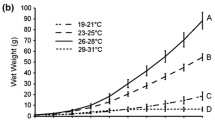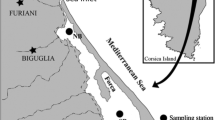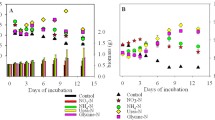Abstract
The results of a study of nutrient enrichment with nitrogen (N) and phosphorus (P) on productivity and calcification of fleshy and calcareous algae are reported in this study. Plants were collected from a nearshore eutrophic site in the Florida Keys (USA) and experimentally pulsed during the night with combinations of N and P. After several days of pulsing (7–10 days), net productivity, calcification, and alkaline phosphatase activity (APA), were measured. Productivity of fleshy algae were frequently enhanced by N, P, and N+P, during both summer and winter. Phosphorus limited the productivity of Hydroclathrus clathratus during winter and Ulva spp. during summer, whereas nitrogen limited the productivity of Laurencia intricata during both seasons. During summer, Dictyota cervicornis productivity was not enhanced by any nutrient enrichment. Nitrogen limited the productivity of the three calcareous species Penicillus capitatus, Penicillus dumetosus and Halimeda opuntia during winter and that of H. opuntia during summer. Neither N nor P enrichment increased calcification of calcareous species, and P enrichment greatly inhibited calcification of P. dumetosus during winter. Nutrient enrichment enhanced the productivity of the fleshy species to a greater extent than that of calcareous algae. The seawater DIN:SRP molar ratio was low at our eutrophic study site (molar ratio average of 3:1 during winter and 9:1 during summer) compared to more oligotrophic sites in the Florida Keys, suggesting that in carbonate-rich environments, eutrophication shifts nutrient regulation of productivity from P to N. APA activities of fleshy macroalage were higher than calcareous algae, and rates of all macro algae were 2- to 7-fold higher in summer compared to winter. Productivity was also about 3-fold higher in fleshy compared to calcareous species and about 2-fold higher in summer compared to winter. These results suggest that nutrient enrichment enhances productivity of fleshy algae to a greater extent than that of calcareous algae. Thus, overgrowth of calcareous algae by more opportunistic fleshy forms could reduce carbonate accretion in tropical coastlines experiencing increased eutrophication.
Similar content being viewed by others
References
Adey WH, Adey PJ, Burke R, Kaufman L (1977) The Holocene reef systems of eastern Martinique, French West Indies. Atoll Res Bull 218:1–40
Antonius A (1981) Coral reef pathology: a review. In: Gomez D, Birkeland, Buddemeier RW, Johannes RJ, Marsh JA, Tsuda TS (eds) Manila: Marina Sciences Center, University of Philippines. Proc 4th Int Symp Coral Reefs 2:3–6
Arnold KE, Murray SN (1980) Relationships between irradiance and photosynthesis for marine benthic green algae (Chlorophyta) of differing morphologies. J Exp Mar Biol Ecol 43:183–192
Bakus GJ (1966) Some relationships of fishes to benthic organisms in coral reefs. Nature 210:280–284
Banner AH (1974) Kanehoe Bay, Hawaii: urban pollution and a coral reef ecosystem: Proc 2nd Int Coral Reef Symp 2:685–702
Berner RA, Morse JW (1974) Dissolution kinetics of calcium carbonate in sea water IV. Theory of calcite dissolution. Am J Sci 274:108–134
Bohm EL, Goreau TF (1973) Rates of turnover and net accretion of calcium and the role of calcium-binding polysaccharides during calcification in the calcareous alga Halimeda opuntia (L.) Int Rev Gesamten Hydrobiol 58:723–740
Borowitzka MA (1977) Algal calcification. Oceanogr Mar Biol Ann Rev 15:189–223
Borowitzka MA (1979) Calcium exchange and the measurements of calcification rates in the calcareous coralline red alga Amphiroa foliacea. Mar Biol 50:339–347
Borowitzka MA (1982) Mechanisms in algal calcification. In: Progress in phycological research. Elsevier Biomedical Press 133:137–177
Brown V, Ducker SC, Rowan KS (1977) The effect of orthophosphate concentration on the growth of articulated coralline algae (Rhodophytal). Phycologia 16(2):125–131
De Kanel J, Morse JW (1979) The chemistry of orthophosphate uptake from seawater onto calcite and aragonite. Geochim Cosmochim Acta 42:1335–1340
Drew EA (1983) Halimeda biomass, growth rates and sediment generation on reefs in the central Great Barrier Reef Province. Coral Reefs 2:101–110
Edmond JM (1970) High precision determination of alkalinity and total carbon dioxide content of seawater by potentiometric titration. Deep-Sea Res 17:737–750
Ginsburg RN (1956) Environmental relationships of grain size and constituent particles in some south Florida carbonate sediments. Bull Am Assoc Petrol Geol 40:2384–2427
Grasshoff K, Ehrahardt M, Kremling K (1983) Methods of seawater analysis. Verlag Chemie, Weinheim
Hallock P (1988) The role of nutrient availability in bioerosion: consequences to carbonate buildups. Paleogeogr Paleoecol 63:275–291
Hallock P, Schlager W (1986) Nutrient excess and demise of corals reefs and carbonate platforms. Palaios 1:389–398
Hay ME (1984) Predicted spatial escapes from herbivory: how do these affect the evolution of herbivore resistance in tropical marine communities? Oecologia (Berlin) (64):396–407
Heatwole D (1987) Florida keys monitoring study. Water quality assessment of five selected pollutant sources in Marathon, FI. South Florida District, Marathon Branch Office
Hillis-Colinvaux L (1980) Ecology and taxonomy of Halimeda: primary producer of coral reef. Adv Mar Biol 17:1–327
Hillis-Colinvaux L (1986a) Halimeda growth and diversity on the deep fore-reef of Enewetak Atoll. Coral Reefs, 5:19–21
Hillis-Colinvaux, L (1986b) Historical perspectives on algae reefs: have reefs been misnamed? Oceanus 29(2):43–48
Jensen PR, Gibson RA, Littler MM, Littler DS (1985) Photosynthesis and calcification in four deep-water Halimeda species (Chlorophyceae. Caulerpales). Deep Sea Res 32:451–464
Johannes RE (1980) The ecological significance of the submarine discharge of groundwater. Mar Ecol Prog Ser 3:365–373
Kinsey DW, Davies PJ (1979) Effects of elevated nitrogen and phosphorus on coral reef growth. Limnol Oceanogr 24:935–940
Kinzie RA, Hunter T (1987) Effects of light quality on photosyntheseis of the reef coral Montipora verucosa. Mar Biol 94:95–109
Kuenzler EJ, Perras JP (1965) Phosphatase of marine algae. Biol Bull 128:271–284
Lapointe BE (1987) Phosphorus-and nitrogen-limited photosynthesis and growth of Gracillaria tikvahiae (Rhodophyceae) in the Florida Keys: an experimental field study. Mar Biol 93:561–568
Lapointe BE (1989) Macroalgal production and nitrient relations in oligotrophic areas of Florida Bay. Bull Mar Sci 44(1):312–323
Lapointe BE, Clark MW (1991) Ambient water quality in the Middle and Lower Florida Keys during summer 1989 and winter 1990. Interim Report Monroe County, Florida
Lapointe BE, Littler MM, Littler DS (1987) A comparison of nutrient limited productivity in macroalgae from Caribbean barrier reef and from mangrove ecosystem. Aquat Bot 28:243–255
Lapointe BE, O'Connell JD (1989) Nutrient-enhanced growth of Cladophora prolifera in Harrington Sound, Bermuda: eutrophication of confined, phosphorus-limited marine ecosystem. Est Coast Shelf Sci 28:347–360
Lapointe BE, O'Connell JD, Garret GS (1990) Nutrient coupling on-site sewage disposal systems, groundwaters, and nearshore surface waters of the Florida Keys. Biogeochem 10:289–307
Lapointe BE, Tenore KR, Dawes CJ (1984) Interactions between light and temperature on physiology of Gracillaria tikvahiae (Gigartinales: Rodophyta). I. Gross photosynthesis and respiration. Mar Biol 80:161–170
Lapointe BE, Littler MM, Littler DS (1992) N:P availability to marine macroalgae in siliciclastic versus carbonate-rich coastal waters. Estuaries 15(1):75–82
Lewis SM (1985) Herbivory on coral reefs: algal susceptibility to herbivorous fishes. Oecologia (Berlin) 65:370–375
Lewis SM, Wrainwright PC (1985) Herbivore abundance and grazing intensity on Caribbean coral reef. J Exp Mar Biol Ecol 87:215–228
Littler MM (1976) Calcification and its role among the macroalgae. Micronesia 12:27–41
Littler MM, Arnold KE (1982) Primary productivity of marine macroalgal functional-form groups from southwestern North America. J Phycol 18:307–311
Littler MM, Doty MS (1975) Ecological components structuring the seaward edges of tropical Pacific reefs: the distribution, communities, and productivity of Porolithon. J Ecol 63:117–129
Littler MM, Littler DS (1980) The evolution of thallus from and survival strategies in benthic marine macroalgae: field and laboratory tests of a functional form model. Am Nat 116(1):25–44
Littler MM, Litter DS (1984) Models of tropical reef biogenesis: the contribution of algae. In: Round N Chapman (eds) Progress in phycological research vol 3 Biopress pp 323–361
Littler MM, Littler DS, Taylor PR (1987) Animal-plant defense associations: effects on the distribution and abundance of tropical macrophytes. J Exp. Mar Biol Ecol 61:676–687
Littler MM, Littler DS, Lapointe BE (1988) A comparison of nutrient-and light-limited photosynthesis in psammophytic versus epilithic forms of Halimeda (Caulerpales, Halimedaceae) from Bahamas. Coral Reefs 6:219–225
Margalef R (1974) Ecologia. Omega Barcelona
Markely SM (1982) Photosynthesis and light-enhanced calcification in the green alga Halimeda opuntia. PhD Thesis. University of Miami,
Marsh JA (1977) Terrestrial inputs of nitrogen and phosphorus on fringing reefs of Guam. Proc 2nd Int Coral Reef Symp. 1 Biology. University of Miami, Miami Florida, pp 331–331
McConnaughey T (1988) Biomineralization mechanisms. In: Origin and modern aspects of biomineralization in plants and animals Plenum Press, New York pp 57–73
Milliman JD (1974) Recent sedimentary carbonates. Marine carbonates. Part I. Springer, Berlin Heidelberg New York,
Morse JW (1974) Dissolution kinetics of calcium carbonate in seawater. Effects of natural inhibitors and position of the chemical lysocline. Am J Sci 274:638–647
Paul VJ, Hay ME (1986) Seaweed susceptibility to herbivory: chemical morphological correlates. Mar Ecol Prog Ser 33 (3):255–264
Pentecost A (1980) Calcification in plants. Int Rev Cytol 62:1–27
Short FT, Dennisson WC, Capone DG (1990) Phosphorus-limited growth of the tropical seagrass Syringodium filiforme in carbonate sediments. Mar Ecol Prog Ser 62:160–174
Simkiss K (1964) The inhibitory effect of some metabolites on the precipitation of calcium carbonate from artificial and natural seawater. J Cons Perm Int E Mer 29:6–18
Smith SV (1984) Phosphorus versus nitrogen limitation in the marine environment. Limnol Oceanogr 29:1149–1160
Smith SV, Kimmerer WJ, Laws EA, Brock RE, Walsh TW (1981) Kaneohe Bay sewage diversion experiment: perspectives on ecosystem responses to nutritional perturbation. Pac Sci 35:279–397
Stockman KW, Ginsburg RN, Shinn EA (1967) The production of lime mud by algae in south Florida. J Sed Pet 37:633–648
Stoddart DR (1969) Ecology and morphology of recent coral reefs. Biol Rev 44:433–498
Strickland JDH, Parsons TR (1972) A practical handbook of seawater analysis. 2nd edn. Fish Res Board Can Otawa, Bull 167
Tomascik T, Sander S (1987) Effects of eutrophication on reef-building corals. II. Structure of selereactinian corals communities on fringing reefs, Barbados, West Indies. Mar Biol 94:53–75
Walker DI, Ormond RF (1982) Coral death from sewage and phosphate pollution of Aqaba, Red Sea. Mar Pollut Bull (13)1:21–25
Wallentius I (1984) Comparison of nutrient uptake rates for Baltic macroalgae with different thallus morphologies. Mar Biol 80: 215–225
Wefer G (1980) Carbonate production by algae Halimeda, Penicillus and Padina. Nature 285:323–324
Zabala M, Ballesteros E (1989) Surface-dependent strategies and energy flux in benthic marine communities or, why corals do not exist in the Mediterranean. Sci Mar 53(1):3–17
Author information
Authors and Affiliations
Rights and permissions
About this article
Cite this article
Delgado, O., Lapointe, B.E. Nutrient-limited productivity of calcareous versus fleshy macroalgae in a eutrophic, carbonate-rich tropical marine environment. Coral Reefs 13, 151–159 (1994). https://doi.org/10.1007/BF00301191
Accepted:
Issue Date:
DOI: https://doi.org/10.1007/BF00301191




